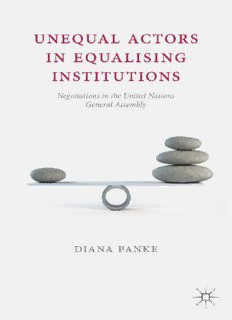Table Of ContentUnequal Actors in Equalising Institutions
This page intentionally left blank
Unequal Actors in Equalising
Institutions
Negotiations in the United Nations
General Assembly
Diana Panke
DepartmentofPoliticalScience,UniversityofFreiburg,Germany
palgrave
macmillan
©DianaPanke2013
Softcover reprint of the hardcover 1st edition 2013 978-1-137-36326-8
Allrightsreserved.Noreproduction,copyortransmissionofthis
publicationmaybemadewithoutwrittenpermission.
Noportionofthispublicationmaybereproduced,copiedortransmitted
savewithwrittenpermissionorinaccordancewiththeprovisionsofthe
Copyright,DesignsandPatentsAct1988,orunderthetermsofanylicence
permittinglimitedcopyingissuedbytheCopyrightLicensingAgency,
SaffronHouse,6–10KirbyStreet,LondonEC1N8TS.
Anypersonwhodoesanyunauthorizedactinrelationtothispublication
maybeliabletocriminalprosecutionandcivilclaimsfordamages.
Theauthorhasassertedherrighttobeidentifiedastheauthorofthiswork
inaccordancewiththeCopyright,DesignsandPatentsAct1988.
Firstpublished2013by
PALGRAVEMACMILLAN
PalgraveMacmillanintheUKisanimprintofMacmillanPublishersLimited,
registeredinEngland,companynumber785998,ofHoundmills,Basingstoke,
HampshireRG216XS.
PalgraveMacmillanintheUSisadivisionofStMartin’sPressLLC,
175FifthAvenue,NewYork,NY10010.
PalgraveMacmillanistheglobalacademicimprintoftheabovecompanies
andhascompaniesandrepresentativesthroughouttheworld.
Palgrave®andMacmillan®areregisteredtrademarksintheUnitedStates,
theUnitedKingdom,Europeandothercountries.
ISBN 978-1-349-47294-9 ISBN 978-1-137-36327-5 (eBook)
DOI 10.1057/9781137363275
Thisbookisprintedonpapersuitableforrecyclingandmadefromfully
managedandsustainedforestsources.Logging,pulpingandmanufacturing
processesareexpectedtoconformtotheenvironmentalregulationsofthe
countryoforigin.
AcataloguerecordforthisbookisavailablefromtheBritishLibrary.
AcatalogrecordforthisbookisavailablefromtheLibraryofCongress.
Contents
ListofTablesandFigures vii
Preface viii
ListofAbbreviations x
1 Introduction 1
1.1 Theresearchquestionandtheargument 3
1.2 ContributionstoInternationalRelationsresearch 6
1.3 Chapteroutline 8
2 TheUnitedNationsGeneralAssembly:FormalEquality
andSizeDifferences 13
2.1 TheUnitedNationsGeneralAssemblyandthe
equality-of-statesprinciple 13
2.2 TheUNmemberstates:Sizedifferencesandchallenges 15
2.3 MappingactiveparticipationintheUNGApolicycycle 22
2.4 Mappingeffectiveparticipation:Influenceandsuccess
intheUnitedNationsGeneralAssembly 29
3 Theory 33
3.1 TheorisingactiveparticipationintheUNGApolicycycle 33
3.2 Theorisingeffectiveparticipation:Influenceandsuccess 49
4 EmpiricsI:ActiveParticipation 56
4.1 Participationinthepolicy-initiationstage(DV1a) 56
4.2 Participationinthenegotiationstage(DV1b) 67
4.3 Participationinthedecision-takingstage(DV1c) 77
4.4 Sizedifferencesandactiveparticipation 85
5 EmpiricsII:EffectiveParticipationintheUNGA 93
5.1 Thenegotiationstage:InfluenceintheUNGA(DV2a) 93
5.1.1 TheAfricandescentcaseandColombia:Aleast
likelycaseforsmallstateinfluence 95
5.1.2 TheICJfollow-upresolutiononnuclearweapons:
Asmallstateinabiggroup–negotiatingwith
stringsattached 102
5.1.3 MexicoandtheLatinAmerican
nuclear-weapon-free-zone:Howbiggerstates
negotiate 109
v
vi Contents
5.1.4 IndiaandtheConventionontheProhibitionofthe
UseofNuclearWeapons:Howbigstatescanexploit
biggroups 115
5.1.5 TheEUandtheMyanmarresolution:Howasmaller
groupnegotiates 120
5.1.6 TheG77andtheeliminationofracismcase:Howa
biggroup conductsmultilateralnegotiations 130
5.2 Thevotingstage:SuccessintheUNGA(DV2b) 137
5.3 Sizedifferences,influenceandsuccess 142
6 Conclusions 149
6.1 Theargumentandmajorfindings 149
6.2 Theimportanceofinstitutionaldesign 156
6.3 Smallstates:Punchingabovetheirweights
inmultilateralnegotiations? 158
Appendix 164
Notes 175
Literature 231
Index 247
Tables and Figures
Tables
2.1 Additivesizeindex(0–200) 18
2.2 AnnualaveragesofsponsorshipforUNGAresolutions
1999/2000–2009/2010 25
2.3 AgendaitemsintheUNGA(GA54–64) 26
2.4 VotingpatternintheUNGA,sessions1999/2000–2009/2010 26
2.5 Averageparticipationratesinthedecision-takingstageby
memberstates,sessions54–64 28
2.6 Averagesuccess-ratesbymemberstates,sessions54–64 31
3.1 Overviewofhypotheses(DV1:Activeparticipation) 43
3.2 Hypothesesoninfluence(DV2a)andsuccess(DV2b) 53
4.1 Regressionresults:Participationinthepolicy-initiation
stage(DV1a) 60
4.2 Regressionresults:Participationindecision-taking(DV1c) 78
4.3 Overviewoffindings–Activeparticipation(DV1) 86
5.1 Regressionresults:Successinthevotingstage(DV2b) 139
5.2 Overviewoffindings–effectiveparticipation(DV2) 143
A1 UNGAmemberstatesinthedecision-takingstage,averages
GA54–64(datasources,cf.Chapter2) 164
A2 Policysubsetmodels–DV1c(activeparticipationinthe
decision-takingstage) 167
A3 Policysubsetmodels–DV2b(successinthe
decision-takingstage) 171
Figures
3.1 Activeparticipation 34
3.2 Developmentofnationalpositions 36
3.3 Capital-basedcoordinationsystems 37
3.4 Mission-basedcoordinationsystems 38
4.1 Theactivitymodel 57
6.1 Position-formation,participation,influenceandsuccess 154
vii
Preface
ThemajorinterestdrivingtheprojectUnequalActorsinEqualisingInstitutions
has been to explore the interplay between formal rules and real-world dif-
ferences. More precisely, I wanted to examine to what extent variation in
size-relatedcapacitiesbetweenstatesmattersforthedynamicsandoutcomes
of negotiations taking place in an institutional environment that strongly
reflects the one-state, one-vote principle. In a previous project, I focused
on the role of small states in the European Union (EU). In this context,
size-relatedcapacitydifferencesbetweenthememberstatesarefarlesspro-
nounced than in the United Nations General Assembly (UNGA) where a
microstate, such as Tuvalu or Palau, can face a superpower more than sev-
eral hundred times its size, such as the USA or China. At the same time,
however,theformalrulesguidingordinarydecisionmakingdifferconsider-
ably:intheEU’sCouncilofMinisters,aweightedvotingsystemisinplace
grantingbiggerstatesmorepower,whileintheUNGAallstatesareformally
equal.Thus,IbecameinterestedintheUNGAbecauseitisaverygoodtest-
ing ground to examine how and under which conditions different types
of capacities matter and to what extent such real-world differences mod-
ify the equalising effect of an institutional design based on the equality of
sovereign states, which is dominant in today’s international organisations.
Iverymuchenjoyedtheprojectandhopethatthisisreflectedinthisbook,
whichsummarisesthemajorfindings.
Different aspects of the project were financially supported by Univer-
sity College Dublin (seed funding, “Small States in the United Nations –
ChallengesandOpportunities”),theFritz-ThyssenFoundation(travelgrant
(Az. 50.11.0.028), “Games Unequal Actors Play”) and the Irish Research
Council for Humanities and Social Sciences (New Ideas Scheme “EU @UN:
EffectivelySpeakingwithOneVoice?”).Withoutthesesmallgrants,Iwould
not have been able to collect the required data and to travel to New York
severaltimesbetween2010and2012,conductingmorethan160interviews
with diplomats from larger and smaller states. I am extremely grateful to
everyone who was willing to be interviewed in the various stages of the
project. This way I – as an academic outsider – got a good idea of how
negotiations are conducted in practice in such a big setting as the UNGA.
It goes without saying that the book would have been written very differ-
ently (if not accomplished at all) without the insights obtained from the
helpofthediplomats.
I presented different parts of my work at European and international
conferences and the book undoubtedly benefited from the inputs of con-
structive discussions. Special thanks go to the following colleagues for
viii
Preface ix
their very helpful comments: Samuel Brazys, Eugénia da Conceição-Heldt,
Nicole Deitelhoff, Adrian O’Hagan, Tobias Hofmann, Liesbet Hooghe, Koji
Kagotani,MichaelH.SmithandLoraViola.
I am also grateful to Finbar Hefferon, Christopher Lute, Stephen Massey,
Adrian O’Hagan, Paul Quinn and Michael Verspohl. These former students
worked as research assistants and did a very good job in supporting the
data collection stages of the project. Moreover, I would like to thank Sally
Hayden,StephaniePollhammerandSabineRoseforproofreadingtheentire
manuscript.

